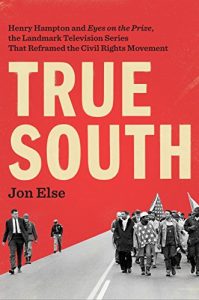The inside story of one of the most important and influential TV shows in history.
“No one is better suited to write this moving account of perhaps the greatest American documentary series ever made. Jon Else helped film it, and, two decades earlier, as a civil rights worker in the South, he lived through part of the history involved. He tells the story with the compassion and eloquence it deserves.”
--Adam Hochschild, author of KING LEOPOLD’S GHOST, BURY THE CHAINS, and TO END ALL WARS
To be published on the 30th anniversary of the initial broadcast, which reached 100 million viewers.
Henry Hampton’s 1987 landmark multipart television series, Eyes on the Prize, an eloquent, plainspoken chronicle of the civil rights movement, is now the classic narrative of that history. Before Hampton, the movement’s history had been written or filmed by whites and weighted heavily toward Dr. King’s telegenic leadership. Eyes told the story from the point of view of ordinary people inside the civil rights movement—the “fan ladies” and “ordinary world parishioners,” mostly African American. Hampton shifted the focus from victimization to strength, from white saviors to black courage. He recovered and permanently fixed the images we now all remember (but had been lost at the time)—Selma and Montgomery, pickets and fire hoses, ballot boxes and mass meetings.
Jon Else was Hampton’s series producer and his moving book focuses on the tumultuous eighteen months in 1985 and 1986 when Eyes was finally created. It’s a point where many wires cross: the new telling of African American history, the complex mechanics of documentary making, the rise of social justice film, and the politics of television (the Boston Globe and New York Times published articles about Henry’s bitter funding problems, in which they named major foundations and corporations like IBM, Xerox, and GM that had declined to support his telling the civil rights story). And because Else, like Hampton and many of the key staffers, was himself a veteran of the movement, his book braids together battle tales from their own experiences as civil rights workers in the south in the 1960s.
Eyes re-introduced Emmett Till to a world that had forgotten him and showed us the guts it took to cross the Pettus Bridge in Selma or walk up the school steps in Little Rock. It chronicled that great expansion of American democracy through legal victories, direct action, voter registration, and legislation. Hampton was not afraid to show the movement’s raw realities: conflicts between secular and religious leaders, the shift toward black power and armed black resistance in the face of savage white violence. It is all on the screen, and the fight to get it all into the films was at times as ferocious as the history being depicted. Henry Hampton utterly changed the way social history is told, taught, and remembered today.
From the Hardcover edition.
“No one is better suited to write this moving account of perhaps the greatest American documentary series ever made. Jon Else helped film it, and, two decades earlier, as a civil rights worker in the South, he lived through part of the history involved. He tells the story with the compassion and eloquence it deserves.”
--Adam Hochschild, author of KING LEOPOLD’S GHOST, BURY THE CHAINS, and TO END ALL WARS
To be published on the 30th anniversary of the initial broadcast, which reached 100 million viewers.
Henry Hampton’s 1987 landmark multipart television series, Eyes on the Prize, an eloquent, plainspoken chronicle of the civil rights movement, is now the classic narrative of that history. Before Hampton, the movement’s history had been written or filmed by whites and weighted heavily toward Dr. King’s telegenic leadership. Eyes told the story from the point of view of ordinary people inside the civil rights movement—the “fan ladies” and “ordinary world parishioners,” mostly African American. Hampton shifted the focus from victimization to strength, from white saviors to black courage. He recovered and permanently fixed the images we now all remember (but had been lost at the time)—Selma and Montgomery, pickets and fire hoses, ballot boxes and mass meetings.
Jon Else was Hampton’s series producer and his moving book focuses on the tumultuous eighteen months in 1985 and 1986 when Eyes was finally created. It’s a point where many wires cross: the new telling of African American history, the complex mechanics of documentary making, the rise of social justice film, and the politics of television (the Boston Globe and New York Times published articles about Henry’s bitter funding problems, in which they named major foundations and corporations like IBM, Xerox, and GM that had declined to support his telling the civil rights story). And because Else, like Hampton and many of the key staffers, was himself a veteran of the movement, his book braids together battle tales from their own experiences as civil rights workers in the south in the 1960s.
Eyes re-introduced Emmett Till to a world that had forgotten him and showed us the guts it took to cross the Pettus Bridge in Selma or walk up the school steps in Little Rock. It chronicled that great expansion of American democracy through legal victories, direct action, voter registration, and legislation. Hampton was not afraid to show the movement’s raw realities: conflicts between secular and religious leaders, the shift toward black power and armed black resistance in the face of savage white violence. It is all on the screen, and the fight to get it all into the films was at times as ferocious as the history being depicted. Henry Hampton utterly changed the way social history is told, taught, and remembered today.
From the Hardcover edition.






